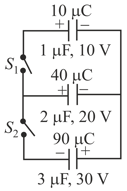B M Sharma Solutions for Chapter: Capacitor and Capacitance, Exercise 1: Concept Application Exercise
B M Sharma Physics Solutions for Exercise - B M Sharma Solutions for Chapter: Capacitor and Capacitance, Exercise 1: Concept Application Exercise
Attempt the free practice questions on Chapter 4: Capacitor and Capacitance, Exercise 1: Concept Application Exercise with hints and solutions to strengthen your understanding. PHYSICS for Joint Entrance Examination JEE (Advanced) Electrostatics and Current Electricity solutions are prepared by Experienced Embibe Experts.
Questions from B M Sharma Solutions for Chapter: Capacitor and Capacitance, Exercise 1: Concept Application Exercise with Hints & Solutions
A capacitor of capacitance is charged to a potential difference The terminals of the charged capacitor are then connected to those of an uncharged capacitor of capacitance
(a) Compute the original charge of the system.
(b) Find the final potential difference across each capacitor.
(c) Find the final energy of the system.
(d) Calculate the decrease in energy when the capacitors are connected.
(e) Where did the "lost" energy go?
A parallel plate vacuum capacitor with plate area and separation has charges and on its plates. The capacitor is disconnected from the source of charge, so the charge on each plate remains fixed.
(a) What is the total energy stored in the capacitor?
(b) The plates are pulled apart an additional distance What is the change in the stored energy?
(c) If is the force with which the plates attract each other, then the change in the stored energy must equal the work done in pulling the plates apart. Find an expression for
(d) Explain why is not equal to where is the electric field between the plates?
A capacitor of capacitance , which is initially charged up to a potential difference , is connected with a battery of emf such that the positive terminal of the battery is connected with the positive plate of the capacitor. Find the heat loss in the circuit during the process of charging.
A capacitor of capacitance , which is initially charged up to a potential difference , is connected with a battery of emf such that the positive terminal of the battery is connected with the positive plate of the capacitor.
Now, if the positive terminal of the battery is connected with the negative plate of the capacitor, find the heat loss in the circuit during the process of charging.
A radioactive source in the form of a metal sphere of diameter emits particles at a constant rate of particles per second. If the source is electrically insulated, how long will it take (in ) for its potential to rise by , assuming that emitted particles escape from the surface.
The plates of a capacitor are charged to a potential difference of and then connected across a resistor. The potential difference across the capacitor decays exponentially with respect to time. After one second the potential difference between the plates of the capacitor is . What is the fraction of the stored energy which has been dissipated?
A parallel plate capacitor of capacitance is charged using a battery of emf . Calculate the work done by external agent in reducing the separation between the plates to half its original value if
(a) The battery is disconnected before you start decreasing the plate separation.
(b) The battery remains connected while you are reducing the separation.(Assume that the plates were moved very slowly)
Three capacitors of capacities , and are charged by , and respectively. Now, positive plates of first two capacitors are connected with the negative plate of third capacitor on one side and negative plates of first two capacitors are connected with positive plate of third capacitor on the other side. Find
(a) common potential .
(b) final charges on different capacitors.

